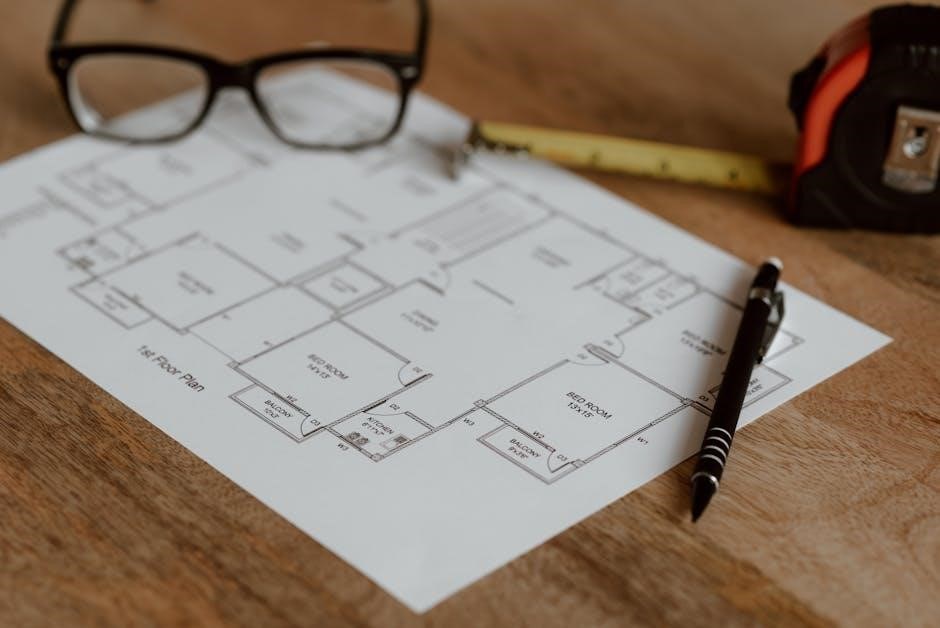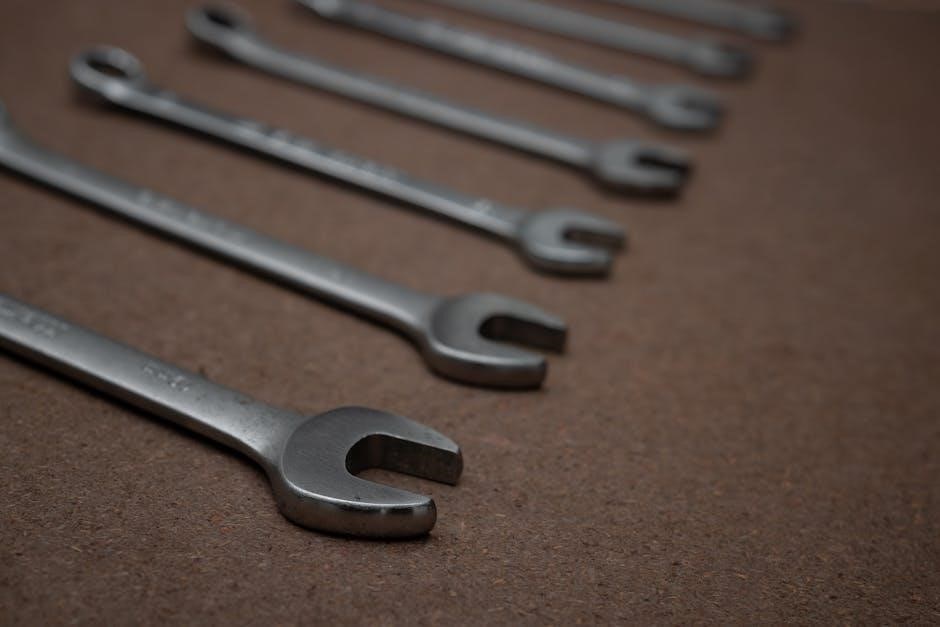Welcome to the Line 6 DL4 Manual‚ your comprehensive guide to mastering the DL4 Delay Modeler. This manual helps you unlock its full potential‚ featuring detailed instructions‚ delay models‚ looping capabilities‚ and customization options to enhance your sound.
1.1 Overview of the Line 6 DL4 Delay Modeler
The Line 6 DL4 Delay Modeler is a versatile effects pedal designed to deliver a wide range of delay sounds and looping capabilities. It combines classic delay models with modern features‚ offering digital‚ analog‚ tape‚ and reverse delay options. The DL4 also includes a built-in loop sampler‚ allowing for real-time recording and playback of loops. With MIDI control and customizable presets‚ it provides extensive creative possibilities for guitarists. This overview highlights the pedal’s core functions‚ making it an essential tool for musicians seeking to enhance their sound with rich‚ dynamic delay effects and looping.
1.2 Importance of the Manual for Optimal Use
The Line 6 DL4 manual is essential for unlocking the pedal’s full potential‚ providing detailed instructions for its advanced features. It guides users through delay models‚ loop sampler mode‚ and MIDI customization‚ ensuring optimal performance. The manual also offers troubleshooting tips and firmware update instructions‚ helping musicians maintain and enhance their sound. By following the manual‚ users can navigate the DL4’s interface effortlessly‚ explore creative possibilities‚ and resolve common issues. This resource is indispensable for both novice and experienced players aiming to maximize the pedal’s capabilities and achieve professional-grade results.
1.3 Key Features Highlighted in the Manual
The Line 6 DL4 manual emphasizes its core features‚ including multiple delay models‚ loop sampler mode‚ and MIDI control. It details the loop sampler’s recording and overdubbing capabilities‚ as well as the customizable delay settings. The manual also highlights additional effects like reverb and tonal shaping options. These features are designed to enhance creativity and versatility‚ allowing users to craft unique sounds. By exploring these highlights‚ musicians can optimize their use of the DL4 for both live performances and studio recordings‚ unlocking its full sonic potential.

Features of the Line 6 DL4
The Line 6 DL4 offers multiple delay models‚ loop sampler mode‚ MIDI control‚ and additional effects like reverb. Its user-friendly design enhances live and studio performances with versatility.
2.1 Delay Models and Their Functions
The Line 6 DL4 features a variety of delay models‚ each designed to deliver unique sonic experiences. The Digital Delay provides crisp‚ clean repeats‚ ideal for modern sounds. The Analog Delay mimics classic bucket-brigade circuits‚ offering warm‚ organic tones. The Tape Delay model captures the nostalgic‚ saturated sound of vintage tape machines. Additionally‚ the Reverse Delay allows for creative soundscapes by playing echoes backward. These models cater to diverse musical genres‚ making the DL4 a versatile tool for guitarists seeking rich‚ dynamic delay effects.
2.2 Loop Sampler Mode and Its Capabilities
The Line 6 DL4’s Loop Sampler Mode is a powerful feature that allows guitarists to record‚ playback‚ and manipulate loops effortlessly. With a generous 14 seconds of mono or 6.2 seconds of stereo recording time‚ players can create intricate layers or capture inspiring moments. The mode also supports overdubbing‚ enabling the addition of new sounds over existing loops for rich textures. Loops can be synced to a desired tempo‚ ensuring seamless integration with live performances. This functionality makes the DL4 an exceptional tool for both practice and creative expression‚ offering endless possibilities for sound exploration and experimentation.
2.3 MIDI Control and Customization Options
The Line 6 DL4 offers extensive MIDI control and customization options‚ allowing for precise external command over its functions. By connecting a MIDI controller‚ users can switch delay models‚ adjust parameters‚ and even control effects in real time. Custom MIDI assignments enable players to tailor the pedal’s response to their specific needs‚ ensuring seamless integration into live rigs or studio setups. This feature enhances versatility and provides unparalleled control for musicians seeking to optimize their sound and performance.
2.4 Additional Effects and Reverb Options
The Line 6 DL4 extends its versatility with a range of additional effects and reverb options. Beyond delay‚ the pedal includes distortion‚ modulation‚ and EQ effects‚ allowing for a broader sonic palette. Reverb options such as spring and plate simulations add depth and ambiance to your sound. These effects can be combined with delay settings to create complex‚ layered tones. With adjustable parameters‚ users can tailor these effects to suit their musical style‚ enhancing the overall richness and diversity of their soundscapes. This feature makes the DL4 a comprehensive tool for creative musicians.

Installation and Setup Guide
This section provides step-by-step instructions for setting up the DL4‚ including unboxing‚ connecting to your guitar rig‚ and initial configuration for optimal performance.
3.1 Unboxing and Initial Setup Instructions
Carefully unbox the Line 6 DL4‚ ensuring all components‚ including the pedal‚ power supply‚ USB cable‚ and manual‚ are accounted for. Begin by plugging in the power supply and connecting the pedal to your guitar rig. Start with a simple setup: connect your guitar to the input jack and your amplifier to the output jack. Power on the DL4 and ensure the LED lights up. Familiarize yourself with the controls and basic functions before diving into advanced features. This initial setup ensures a smooth start to exploring the DL4’s capabilities.
3.2 Connecting the DL4 to Your Guitar Rig
To connect the Line 6 DL4‚ start by plugging your guitar into the pedal’s input jack. Use a standard 1/4-inch cable to ensure a secure connection. Next‚ connect the DL4’s output jack to your amplifier or effects loop. For optimal signal flow‚ use the correct input and output cables. If using an effects loop‚ ensure the DL4 is placed in the correct position within your chain. Power on the pedal and test the connection by playing your guitar. Adjust the output level as needed to match your rig’s signal strength. Proper connection ensures clear tone and reliable performance.
3.3 Updating Firmware for Enhanced Performance
Updating the DL4’s firmware ensures access to the latest features‚ improvements‚ and bug fixes. Visit the Line 6 website to download the most recent firmware version. Connect your DL4 to a computer using a USB cable‚ then follow the on-screen instructions in Line 6 Monkey software; Ensure the pedal is powered on and avoid interrupting the update process. Once complete‚ the DL4 will reboot with enhanced functionality. Regular firmware updates are crucial for maintaining optimal performance and unlocking new capabilities. This step keeps your pedal up-to-date and performing at its best.

Operating the Line 6 DL4
Navigate the DL4’s intuitive interface with ease. Control delay time‚ feedback‚ and tone shaping using dedicated knobs. Access deeper features via the “Tweez” knob for precise adjustments.
4.1 Navigating the User Interface
Navigating the Line 6 DL4 is straightforward due to its intuitive design. The LCD screen displays essential parameters‚ while dedicated knobs simplify control. Use the “Delay Time” and “Feedback” knobs to adjust your sound. The “Tweez” knob fine-tunes tone‚ offering precise adjustments; Function buttons allow quick access to delay models‚ loop mode‚ and MIDI settings. The user-friendly layout ensures easy access to features‚ making it simple for musicians to experiment and customize their sound without confusion. This design enhances creativity and efficiency during live performances or studio sessions.
4.2 Adjusting Delay Time and Feedback
Adjusting delay time and feedback on the Line 6 DL4 is essential for shaping your sound. The “Delay Time” knob sets the echo interval‚ ranging from 20ms to 2‚800ms. Turn it clockwise for longer delays or counterclockwise for shorter‚ tighter repeats. The “Feedback” knob controls the number of repeats‚ with higher settings creating infinite loops. Experiment with these knobs to achieve the desired balance between clarity and ambiance. Be cautious with high feedback levels‚ as they can lead to self-oscillation. Fine-tuning these parameters ensures your delay effects complement your playing style perfectly.
4.3 Using the Tweez Knob for Tone Shaping
The Tweez knob on the Line 6 DL4 allows precise tone shaping of your delay repeats. Turning it clockwise adds brightness and high-frequency clarity‚ while counterclockwise reduces high-end‚ creating a warmer‚ darker tone. This control is crucial for ensuring your delays blend naturally with your original signal. Experiment with subtle adjustments to find the perfect balance for your sound. Use it to enhance definition in modern tones or achieve vintage warmth. The Tweez knob works in tandem with delay time and feedback‚ enabling seamless integration of delay effects into your music.
Delay Models and Modes
This chapter explores the DL4’s versatile delay models and modes‚ including Digital‚ Analog‚ Tape‚ and Reverse delays‚ each offering unique tonal textures for crafting distinctive sounds.
5.1 Digital Delay Mode for Clean Repeats
The Digital Delay Mode on the Line 6 DL4 delivers crisp‚ clean repeats with exceptional clarity‚ making it ideal for modern‚ precise delay effects. This mode is highly versatile‚ offering a wide range of delay times and feedback options. It’s perfect for creating sharp‚ rhythmic delays or subtle ambience. With its advanced signal processing‚ the Digital Mode ensures that your original tone remains intact while adding a polished‚ contemporary edge to your sound. It’s a go-to choice for players seeking a clean‚ uncolored delay effect that complements their playing style in both live and studio settings.
5.2 Analog Delay Mode for Warm Tones
The Analog Delay Mode on the Line 6 DL4 emulates classic bucket brigade delay technology‚ producing warm‚ organic tones with a natural decay. This mode is perfect for creating rich‚ vintage-inspired soundscapes. The repeats gradually soften and darken‚ adding a nostalgic feel to your playing. Ideal for rock‚ blues‚ and ambient music‚ this mode captures the essence of analog delay pedals from the past. Its warm‚ gritty character makes it a favorite for players seeking a retro‚ authentic delay experience in both live and studio environments.
5.3 Tape Delay Mode for Vintage Effects
The Tape Delay Mode on the Line 6 DL4 recreates the warm‚ rich tones of vintage tape-based delay systems. Modeled after classic multi-head tape machines‚ this mode delivers lush‚ flowing soundscapes with a nostalgic vibe. The repeats exhibit slight pitch fluctuations and gradual degradation‚ mimicking the natural wear of analog tape. Perfect for ambient textures or retro-inspired rhythms‚ the Tape Delay Mode captures the essence of vintage recording equipment‚ offering a unique and organic delay experience that stands out in modern music production.
5.4 Reverse Delay for Creative Soundscapes
The Reverse Delay mode on the Line 6 DL4 offers a unique way to create backward playback effects‚ adding depth and intrigue to your sound. By reversing the delay signal‚ it generates unusual textures and atmospheric layers‚ perfect for experimental music or ambient compositions. Users can adjust the delay time and number of repeats to craft distinctive tones. This mode is ideal for adding a touch of unpredictability to solos or rhythms‚ making it a standout feature for musicians seeking creative expression and unconventional sounds in their performances.

Looping Functions and Sampler Mode
The DL4’s Looping Functions and Sampler Mode allow users to record‚ playback‚ and overdub loops‚ enabling creative layering and sound manipulation. This feature is ideal for live performances and studio use‚ offering a powerful tool for building complex soundscapes and enhancing musical expression.
6.1 Recording and Playing Loops
Recording and playing loops with the Line 6 DL4 is straightforward. Press the Loop switch to start recording‚ and the LED will flash during capture. Once you press the switch again‚ playback begins immediately. You can overdub additional layers by pressing the Loop switch while the loop is playing. The DL4 allows for seamless loop creation‚ with a maximum loop length of 14 seconds. This feature is perfect for live performances‚ enabling musicians to build intricate textures and rhythms on the fly.
- Press the Loop switch to start recording.
- LED flashes during recording.
- Press again to stop and begin playback.
- Overdub by pressing the Loop switch during playback.
- Maximum loop length: 14 seconds.
6.2 Syncing Loops with Your Music
Synchronizing loops with your music on the Line 6 DL4 is essential for maintaining tight timing during performances. The DL4 offers MIDI clock synchronization‚ allowing loops to align perfectly with external devices. Additionally‚ the Tap Tempo feature enables you to set the loop length based on your playing‚ ensuring seamless integration with your rhythm. This functionality is particularly useful for live settings‚ where precise timing is critical. Syncing loops enhances your ability to create cohesive‚ professional-sounding performances.
- Use MIDI clock for external device synchronization;
- Tap Tempo feature matches loop length to your music’s BPM.
- Essential for maintaining precise timing in live performances.
- Enhances overall sound coherence and professionalism.
6.3 Overdubbing and Layering Sounds
Overdubbing and layering sounds on the Line 6 DL4 allows for the creation of rich‚ textured audio. By recording multiple passes over a loop‚ you can build complex soundscapes. The DL4’s unlimited overdubbing capability means you can add as many layers as desired without compromising quality. This feature is ideal for experimenting with harmonies‚ rhythms‚ and atmospheric effects. Layering enhances your musical expression and adds depth to your performances‚ making it a powerful tool for both live and studio applications.
- Unlimited overdubbing for layering sounds.
- Create complex‚ textured audio landscapes.
- Enhance musical expression and performance depth.
- Perfect for both live and studio use.

Advanced Features and Customization
Explore advanced customization options like MIDI control‚ external switch assignments‚ and deep parameter tweaking. Tailor the DL4 to your unique playing style for enhanced creativity and control.
- Customize MIDI mappings for seamless integration.
- Assign functions to external switches for easy access.
- Save and recall custom presets effortlessly.
7.1 Assigning Functions to External Switches
The Line 6 DL4 allows for external switch integration‚ enabling users to control various functions such as bypass‚ tap tempo‚ and preset selection. This feature enhances live performance flexibility by providing quick access to essential controls. Users can assign functions to external switches via the MIDI or control input‚ ensuring seamless integration with their pedalboard setup. This customization option is particularly useful for musicians who prefer hands-free operation or need to trigger multiple effects simultaneously. By assigning functions strategically‚ players can optimize their workflow and focus on delivering dynamic performances.
7.2 Using MIDI to Control the DL4
MIDI control unlocks advanced functionality for the Line 6 DL4‚ allowing seamless integration with external devices; By connecting a MIDI controller or sequencer‚ users can remotely adjust parameters like delay time‚ feedback‚ and preset selection. This feature is ideal for live performances and complex rigs‚ enabling hands-free operation. The DL4 can also receive MIDI clock signals for syncing delays with your tempo. Assigning MIDI commands to specific functions ensures precise control‚ enhancing creativity and efficiency during performances. This capability makes the DL4 a versatile tool for musicians seeking advanced customization.
7.3 Saving and Recalling Presets
Saving and recalling presets on the Line 6 DL4 is a straightforward process that enhances workflow. To save a preset‚ press and hold the “Save” button‚ select an empty slot using the navigation buttons‚ and confirm with the “Save” button again. Presets store delay models‚ effects‚ and parameter settings‚ allowing quick access during performances. The DL4 offers multiple banks for organizing presets‚ catering to different musical scenarios. Recalling a preset is done by selecting the desired slot‚ ensuring seamless transitions between sounds. This feature maximizes efficiency and creativity for musicians.

Maintenance and Troubleshooting
Regular maintenance ensures the DL4 performs optimally. Clean the pedal‚ check connections‚ and update firmware to prevent issues and maintain functionality over time.
8.1 Cleaning and Caring for Your DL4
Regularly clean the DL4 to maintain its performance and longevity. Use a soft‚ dry cloth to wipe the exterior‚ avoiding harsh chemicals or abrasive materials. For stubborn marks‚ dampen the cloth slightly with water‚ but ensure no moisture enters the unit. Handle the footswitches and knobs with care to prevent wear. Avoid exposing the DL4 to extreme temperatures or humidity. Store it in a protective case when not in use to safeguard against dust and damage. Proper care ensures reliable operation and preserves the pedal’s appearance.
8.2 Resolving Common Issues
If the DL4 isn’t functioning properly‚ start by checking all cable connections and ensuring they are secure. If delay time isn’t syncing‚ verify the tempo settings or try resetting the unit. For looping issues‚ ensure the loop mode is enabled and the overdub function is active. If MIDI control isn’t working‚ check the MIDI channel settings and ensure the device is properly configured. Resetting the DL4 to factory settings can often resolve software-related problems. Refer to the manual for detailed troubleshooting steps to address specific issues effectively.
8.3 Resetting the DL4 to Factory Settings
To reset the Line 6 DL4 to its factory settings‚ press and hold the Save and Tweez knobs while powering on the device. This will restore all settings to their original configuration. Note that this process will erase all user-presets and custom settings. Use this feature cautiously‚ as it cannot be undone. For a partial reset‚ refer to the manual for specific instructions on resetting individual parameters. This step is useful when troubleshooting or preparing the pedal for resale.

Comparing the DL4 with Other Delay Pedals
The Line 6 DL4 stands out for its versatility‚ offering a wide range of delay models and additional features like looping and MIDI control‚ surpassing many competitors.
9.1 Unique Selling Points of the DL4
The DL4’s ability to model multiple delay types‚ including digital‚ analog‚ and tape delays‚ sets it apart from competitors. Its built-in loop sampler and extensive MIDI control options enhance versatility for live and studio use. The unit’s compact design‚ combined with its robust feature set‚ makes it a favorite among guitarists seeking a versatile delay pedal. Additionally‚ its user-friendly interface and preset storage capabilities ensure easy access to custom sounds‚ catering to both beginners and advanced players. These features collectively make the DL4 a standout in the market.
9.2 How the DL4 Stands Out in the Market
The DL4’s reputation as a revolutionary pedal stems from its unmatched versatility and comprehensive feature set. It offers a wide range of delay models‚ a built-in loop sampler‚ and extensive MIDI control‚ making it a favorite among professional musicians. Its ability to cater to various musical genres and playing styles sets it apart from competitors. The pedal’s user-friendly design‚ coupled with its robust capabilities‚ ensures it remains a top choice for guitarists seeking a reliable and feature-rich delay pedal. Its enduring popularity solidifies its position as a benchmark in the industry.
9.3 User Preferences and Reviews
Users consistently praise the DL4 for its durability‚ intuitive interface‚ and vast tonal possibilities. Many highlight its ability to deliver both classic and modern delay sounds‚ making it a staple in various genres. The loop sampler and MIDI capabilities are particularly favored by experimental and live performers. While some note its complexity for beginners‚ the majority agree it’s worth the learning curve. Overall‚ the DL4 is celebrated for its reliability and versatility‚ earning it a top spot in many pedalboards and glowing reviews across the music community.

Tips for Getting the Best Sound Quality
Optimize delay settings to match your genre‚ use the Tweez knob for precise tone shaping‚ and ensure a clean signal chain for maximum clarity and effect integrity.
10.1 Optimizing Delay Settings for Your Music
Start by matching the delay time to your song’s tempo using the DL4’s tap tempo feature. For clean‚ precise repeats‚ use Digital Delay. Analog Delay adds warmth‚ while Tape Delay offers vintage vibes. Experiment with feedback levels to control echo decay. Adjust the mix knob to balance wet and dry signals seamlessly. Use tempo sync for consistent rhythmic delays. For ambient textures‚ combine delay with reverb. Fine-tune the Tweez knob to enhance high-frequency clarity. Keep your signal chain clean to avoid noise interference. Tailor these settings to fit your musical style for professional-sounding results every time.
10.2 Using Reverb and Delay Together
Combine reverb and delay for lush‚ immersive soundscapes. Set delay time to match your song’s tempo‚ then add a subtle reverb level to enhance spatial depth. Use the DL4’s mix knobs to balance both effects‚ ensuring neither overwhelms the other. For a natural blend‚ place delay before reverb in the signal chain. Adjust the Tweez knob to brighten or warm the tone. Experiment with different room simulations and delay modes to create unique textures. This combination excels in ambient and indie music‚ offering rich‚ dimensional sound.
10.3 Experimenting with Unconventional Sounds
Push the boundaries of sound design by exploring unconventional techniques with the DL4. Use reverse delay to create eerie‚ reversed echoes or set delay time to unusual subdivisions for rhythmic interest. Experiment with extreme feedback levels for chaotic‚ swirling textures. Combine the loop sampler with delay modes to layer unexpected sounds. Try using the Tweez knob to shape tonal extremes‚ creating bright‚ harsh tones or deep‚ resonant low-end. Assign MIDI controls to manipulate parameters in real-time for dynamic‚ performance-based effects. These methods unlock the DL4’s full creative potential‚ inspiring unique sonic explorations.

User-Generated Content and Community
The Line 6 DL4 community thrives through user-generated content‚ with musicians sharing loops‚ presets‚ and tips online. Join forums and groups to collaborate and learn from experienced users.
11.1 Sharing Loops and Presets Online
Users can easily share their custom loops and presets online‚ fostering a vibrant community of musicians. Platforms like forums and dedicated websites allow seamless exchange of creations. This encourages collaboration and inspiration‚ as players discover new sounds and techniques. Many users upload their favorite settings‚ complete with descriptions and tips. Some communities even host contests or challenges‚ pushing creativity further. By sharing‚ musicians can gain recognition and learn from others’ approaches to delay and looping. This collective resource is invaluable for exploring the DL4’s full potential.
- Share loops and presets via forums or dedicated websites.
- Discover inspiration and learn from others’ creations.
- Participate in community challenges to enhance your skills.
11.2 Joining DL4 User Forums and Groups
Joining DL4 user forums and groups connects you with a vibrant community of musicians. These platforms offer valuable resources‚ tips‚ and troubleshooting advice from experienced users. Members share insights‚ discuss techniques‚ and provide feedback on setups. Additionally‚ these communities often host Q&A sessions and live discussions. By participating‚ you can stay updated on the latest features‚ learn new ways to use the DL4‚ and network with fellow musicians. Engaging with these groups enhances your overall experience and helps you maximize the pedal’s capabilities.
- Connect with experienced DL4 users worldwide.
- Access tips‚ resources‚ and troubleshooting advice.
- Engage in discussions to refine your skills.
- Stay updated on new features and techniques.
11.3 Learning from Experienced Users
Learning from experienced DL4 users is a great way to enhance your skills. Seasoned musicians often share tips‚ tricks‚ and techniques for maximizing the pedal’s potential. By studying their approaches‚ you can discover new sounds‚ improve your workflow‚ and gain insights into advanced features. Engaging with experienced users fosters creativity and helps you avoid common pitfalls. Their real-world applications provide practical knowledge that complements the manual‚ ensuring you get the most out of your DL4.
- Gain practical insights from real-world applications.
- Discover advanced techniques and workflows.
- Inspire your creativity with unique sound designs.
- Learn from others’ experiences to refine your craft.
The Line 6 DL4 is a versatile and powerful tool for guitarists‚ offering unmatched delay and looping capabilities. With its comprehensive manual‚ users can unlock its full potential‚ ensuring optimal performance and creativity in their music.
12.1 Summary of Key Takeaways
The Line 6 DL4 manual provides a comprehensive guide to mastering its delay models‚ looping functions‚ and customization options. It emphasizes the importance of understanding delay time‚ feedback‚ and tone shaping for optimal sound quality. The manual also highlights the pedal’s versatility‚ from digital clarity to vintage tape warmth‚ offering something for every musical style. By exploring its features and following the setup tips‚ users can unlock the DL4’s full potential‚ creating unique sounds and enhancing their musical creativity. This guide ensures guitarists make the most of their DL4 experience.
12.2 Encouragement to Explore the DL4
Embrace the Line 6 DL4 as a gateway to endless creative possibilities. Experiment with its delay models‚ looping capabilities‚ and customization options to craft unique sounds. Push boundaries by blending digital precision with analog warmth‚ creating textures that elevate your music. Don’t be afraid to venture beyond familiar settings—each tweak opens doors to new sonic landscapes. The DL4 is more than a pedal; it’s a tool for innovation‚ inviting you to redefine your sound and inspire your musical journey. Let curiosity guide you to unlock its full creative potential.
12.3 Resources for Further Learning
For deeper exploration of the Line 6 DL4‚ consider these resources; Visit the official Line 6 website for comprehensive guides‚ video tutorials‚ and FAQs. Engage with user communities on forums like GuitarWorld or Reddit‚ where experienced musicians share tips and tricks. YouTube channels dedicated to guitar effects offer hands-on demonstrations. Check out webinars and workshops hosted by professional musicians specializing in delay techniques. Explore books and eBooks on advanced effects processing to enhance your skills and unlock the full potential of your DL4.
